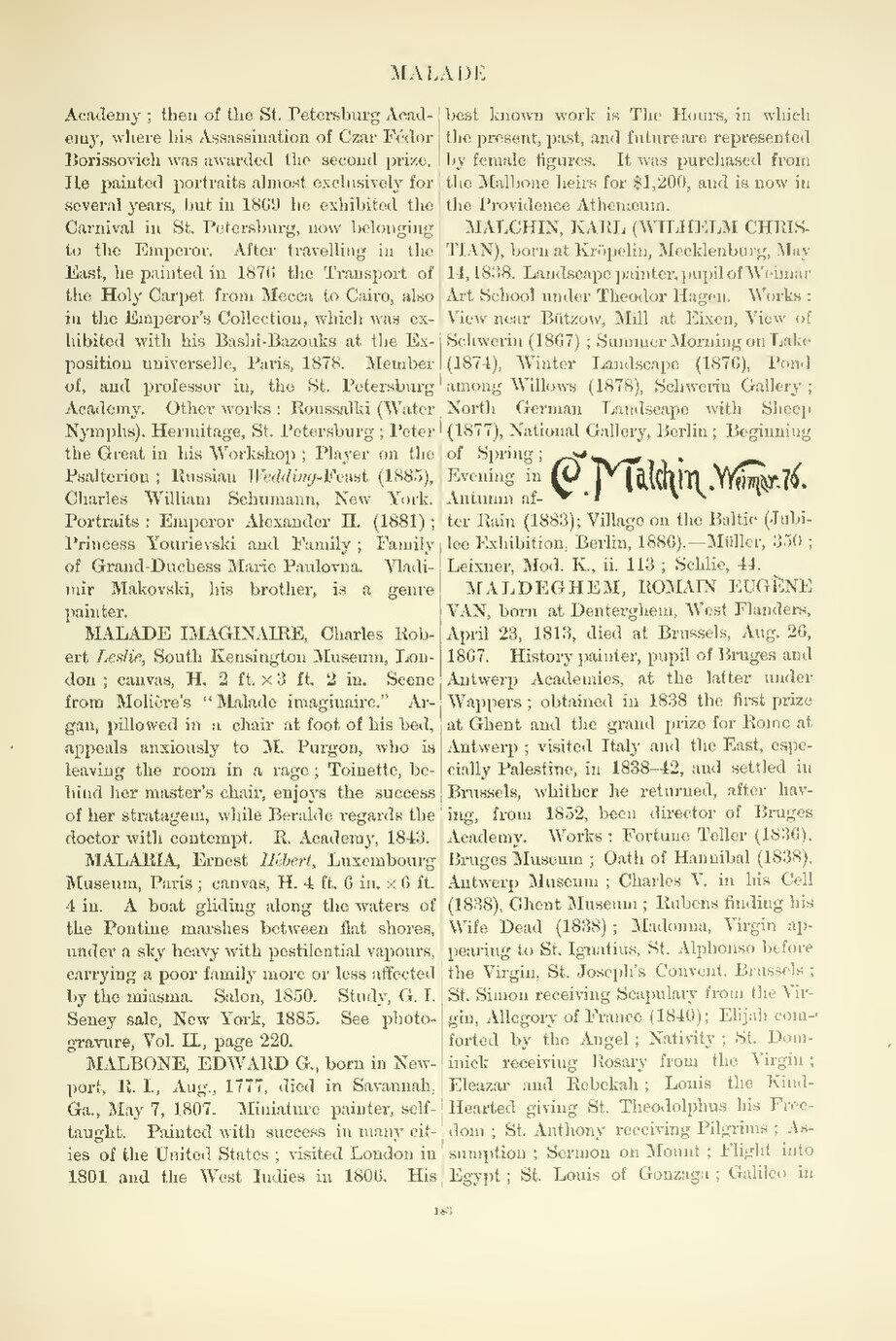Academy; then of the St. Petersburg Academy, where his Assassination of Czar Fédor Borissovich was awarded the second prize. He painted portraits almost exclusively for several years, but in 1869 he exhibited the Carnival in St. Petersburg, now belonging to the Emperor. After travelling in the East, he painted in 1876 the Transport of the Holy Carpet from Mecca to Cairo, also in the Emperor's Collection, which was exhibited with his Bashi-Bazouks at the Exposition universelle, Paris, 1878. Member of, and professor in, the St. Petersburg Academy. Other works: Roussalki (Water Nymphs), Hermitage, St. Petersburg; Peter the Great in his Workshop; Player on the Psalterion; Russian Wedding-Feast (1885), Charles William Schumann, New York. Portraits: Emperor Alexander II. (1881); Princess Yourievski and Family; Family of Grand-Duchess Marie Paulovna. Vladimir Makovski, his brother, is a genre painter.
MALADE IMAGINAIRE, Charles Robert
Leslie, South Kensington Museum, London;
canvas, H. 2 ft. × 3 ft. 2 in. Scene
from Molière's "Malade imaginaire." Argan,
pillowed in a chair at foot of his bed,
appeals anxiously to M. Purgon, who is
leaving the room in a rage; Toinette, behind
her master's chair, enjoys the success
of her stratagem, while Beralde regards the
doctor with contempt. R. Academy, 1843.
MALARIA, Ernest Hébert, Luxembourg
Museum, Paris; canvas, H. 4 ft. 6 in. × 6 ft.
4 in. A boat gliding along the waters of
the Pontine marshes between flat shores,
under a sky heavy with pestilential vapours,
carrying a poor family more or less affected
by the miasma. Salon, 1850. Study, G. I.
Seney sale, New York, 1885. See photo-*gravure,
Vol. II., page 220.
MALBONE, EDWARD G., born in Newport,
R. I., Aug., 1777, died in Savannah,
Ga., May 7, 1807. Miniature painter, self-*taught.
Painted with success in many cities
of the United States; visited London in
1801 and the West Indies in 1806. His
best known work is The Hours, in which
the present, past, and future are represented
by female figures. It was purchased from
the Malbone heirs for $1,200, and is now in
the Providence Athenæum.
An image should appear at this position in the text. To use the entire page scan as a placeholder, edit this page and replace "{{missing image}}" with "{{raw image|Cyclopedia of painters and paintings (IA cyclopediaofpain03cham).pdf/205}}". Otherwise, if you are able to provide the image then please do so. For guidance, see Wikisource:Image guidelines and Help:Adding images. |
MALCHIN, KARL (WILHELM CHRISTIAN),
born at Kröpelin, Mecklenburg, May
14, 1838. Landscape painter, pupil of Weimar
Art School under Theodor Hagen. Works:
View near Bützow, Mill at Eixen, View of
Schwerin (1867); Summer Morning on Lake
(1874), Winter Landscape (1876), Pond
among Willows (1878), Schwerin Gallery;
North German Landscape with Sheep
(1877), National Gallery, Berlin; Beginning
of Spring;
Evening in
Autumn after
Rain (1883); Village on the Baltic (Jubilee
Exhibition, Berlin, 1886).—Müller, 350;
Leixner, Mod. K., ii. 113; Schlie, 44.
MALDEGHEM, ROMAIN EUGÈNE
VAN, born at Denterghem, West Flanders,
April 23, 1813, died at Brussels, Aug. 26,
1867. History painter, pupil of Bruges and
Antwerp Academies, at the latter under
Wappers; obtained in 1838 the first prize
at Ghent and the grand prize for Rome at
Antwerp; visited Italy and the East, especially
Palestine, in 1838-42, and settled in
Brussels, whither he returned, after having,
from 1852, been director of Bruges
Academy. Works: Fortune Teller (1836),
Bruges Museum; Oath of Hannibal (1838),
Antwerp Museum; Charles V. in his Cell
(1838), Ghent Museum; Rubens finding his
Wife Dead (1838); Madonna, Virgin appearing
to St. Ignatius, St. Alphonso before
the Virgin, St. Joseph's Convent, Brussels;
St. Simon receiving Scapulary from the Virgin,
Allegory of France (1840); Elijah comforted
by the Angel; Nativity; St. Dominick
receiving Rosary from the Virgin;
Eleazar and Rebekah; Louis the Kind-Hearted
giving St. Theodolphus his Freedom;
St. Anthony receiving Pilgrims; Assumption;
Sermon on Mount; Flight into
Egypt; St. Louis of Gonzaga; Galileo in
